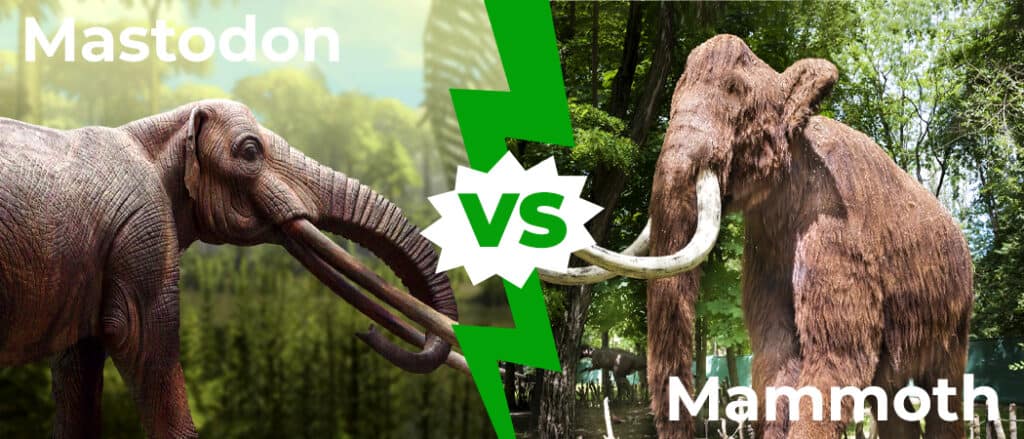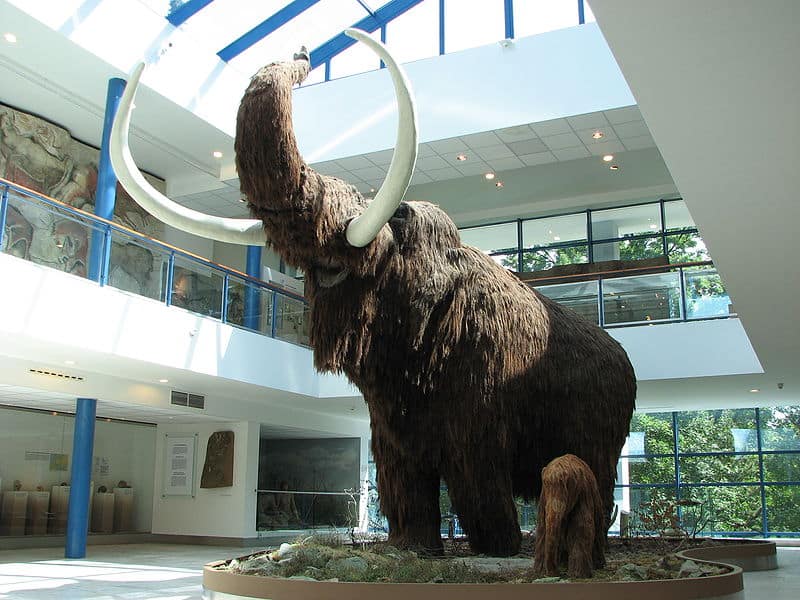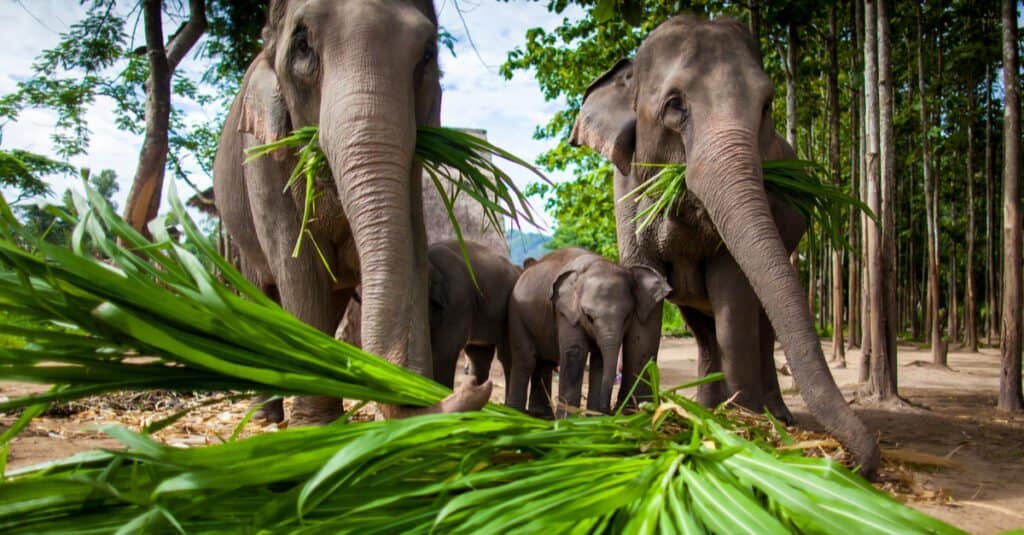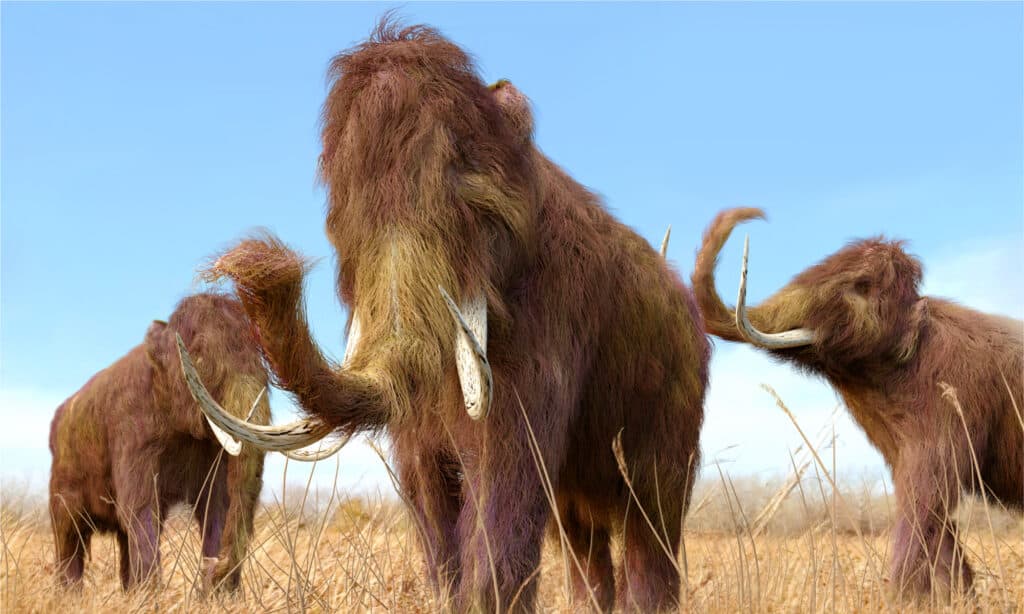Mastodon and woolly mammoth sound like the names of gigantic beasts.
But they weren’t dinosaur-sized. Instead, mastodons and mammoths were closer to the size of ordinary elephants. Their shared size made it easier to survive harsh, cold environments. But the way they chose to survive was very different.
Read on as we unveil the differences between a woolly mammoth vs mastodon.
Comparing Woolly Mammoth vs Mastodon

A-Z-Animals.com
Comparing Woolly Mammoth vs Mastodon: Key Differences
The key differences for the woolly mammoth vs mastodon are appearance, teeth, habitat, diet, and extinction theories.
Mastodons primarily lived throughout North and Central America. But there was a time period when they lived across the globe. Woolly mammoths mainly roamed Northern Asia, North America, and Europe during the ice age.
To date, there have been five mastodon species identified. That compares to the woolly mammoth which is a specific species of mammoth. Comparatively, there have been 10 identified species of mammoths.
Both ancient beasts were herbivores. But there are rumors about mastodons being slightly carnivorous. As far as plant choices, mastodons had a more rough diet. They would choose thorny twigs and hard bits of wood to chew on. Woolly mammoths preferred soft aquatic shrubs and grasses. The differences in the diet are obvious to mammologists studying their teeth.
Finally, no one knows why mastodons or wooly mammoths are extinct. But there are some fascinating theories. Keep reading as we fully unveil the differences between the woolly mammoth vs mastodon.
Comparing Woolly Mammoth vs Mastodon: Height
When it comes to a woolly mammoth vs mastodon, woolly mammoths were taller and heavier. It was normal for a woolly mammoth to reach 13 ft in height and weigh as much as 6 tons. Mastodons usually didn’t grow to be over 10 ft tall, and they weighed between 4 to 6 tons.
Comparing Woolly Mammoth vs Mastodon: Body

Liliya Butenko/Shutterstock.com
What about woolly mammoth vs mastodon bodies? They were both covered in long, shaggy hair. However, mammoths have a knob on the top of their skull, while mastodons have flatter heads. The mammoth’s knob comes from a protrusion of bone.
Woolly mammoths also had a distinctive hump on their backs. The hump most likely worked like a camel hump, storing fat for hard times.
Both mastodons and woolly mammoths had small ears when compared to modern elephants. The smaller ear size made it easy for them to maintain their core body temperatures.
Comparing Woolly Mammoth vs Mastodon: Tusks
Mastodons and woolly mammoths had long, impressive tusks. However, woolly mammoth tusks would grow at a curve and sometimes cross in front of each other. Mastodon tusks had a more linear appearance.
Sometimes Mastodon tusks would even create a small chin tusk beneath their lower jaw. During mastodon mating season, males would use their tusks to fight. Sometimes fighting to the death.
Comparing Woolly Mammoth vs Mastodon: Teeth

HTO – Public Domain
The most distinguishing mastodon vs woolly mammoth characteristics is inside their mouths. Their teeth provide a lot of clues for each species.
The name Mastodon itself means breast tooth. The name refers to the nipple-shaped bumps throughout the edges of mastodon teeth. Mamologists studying mastodon molars believe the ancient beasts ate a lot of wood. The cone-shaped incisor design could efficiently crush twigs and hard bits of vegetation.
Woolly mammoths had more rigid, serrated teeth. Their teeth were suited for vegetation found in riverine environments, such as tough grasses.
Woolly mammoth teeth closely resembled modern elephant teeth. They had four large teeth, two on the top and two on the bottom. They would grow six sets of teeth over their lifetime. They’d reach their final days when their last teeth lost the ability to grind vegetation.
Comparing Woolly Mammoth vs Mastodon: Habitat
Mastodons mainly lived in Central America and throughout North America. However, there was a period when they lived all over the world. You could find mastodons on every single continent, excluding Australia and Antarctica. Some of their favorite environments to live in include valleys, swamps, and woodlands.
A woolly mammoth habitat is called an “mammoth steppe.” Some of the most populated steppes during the ice age include Northern Asia, North America, and Europe. They also thrived throughout Siberia, where they could graze with other herbivores, like bison.
Like modern elephants, woolly mammoths prefer arid habitats along riverine environments. Frequent floods would change the variety of vegetation, giving woolly mammoths a lot of different fauna to graze on.
Comparing Woolly Mammoth vs Mastodon: Diet

hangingpixels/Shutterstock.com
Mastodons and woolly mammoths were herbivores, eating a diet consisting of vegetation. All of the elephant species alive today are herbivores too.
American mastodons ate a tough woody diet. Mastodons in southern regions ate a softer diet.
The range in dietary choices shows the mastodon’s ability to adapt to their environment. When mastodons had a resource-limited environment, they’d eat whatever was necessary to survive. New research suggests they may have even been opportunistically carnivorous.
There aren’t any rumors about woolly mammoths being carnivores. They were strictly herbivores, eating a diet consisting of grasses, aquatic shrubs, and other plants. They would use their highly sensitive trunks to delicately pick apart flowers before eating them. They could also easily reach shorter grasses.
Comparing Woolly Mammoth vs Mastodon: Extinction Theories

Aunt Spray/Shutterstock.com
You might be able to see woolly mammoths in the future! The Revive and Restore Woolly Mammoth Revival Project has the sole goal of reintroducing these ancient elephants to the world.
For now, seeing a woolly mammoth or mastodon in the wild just isn’t possible, no matter where you go. Why did they go extinct?
A naturally warming climate likely played a role in the mastodon’s extinction. The ice age had a way of fluctuating. Sheets of ice would take over different areas of land at other times.
Around 75,000 years ago, ice sheets began taking over North America. The American mastodons stopped existing in the Arctic and began condensing in southern forests. Giant ground sloths had a similar species shaping event around this time.
The last mastodons to roam the Earth were around 11,000 years ago. By the time humans were in prehistoric Alaska, American mastodons were already gone.
What about woolly mammoths? Why aren’t they still around? Woolly mammoth extinction theories include; climate change, human activity, and meteors. There’s even a new theory surrounding a grass invasion.
Woolly mammoths were one of the many megafauna species that preferred forbs (a key source of the mammoth’s protein). Forbs include broad-leafed, flowering plants such as sagebrush or yarrow.
When the small and large flowers disappeared from the Artic’s landscape, woolly mammoths disappeared too.
The post Woolly Mammoth vs Mastodon: What are the Key Differences? appeared first on AZ Animals.
from Animal News, Facts, Rankings, and More! - AZ Animals https://ift.tt/rmtOqc4